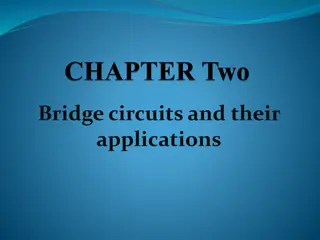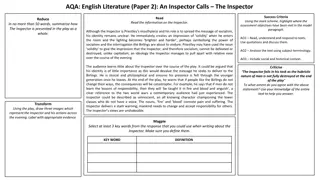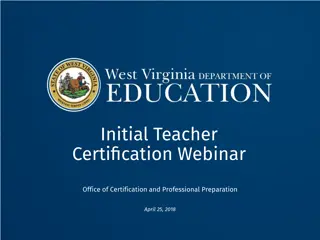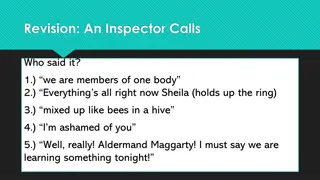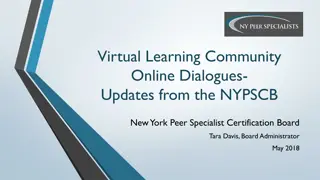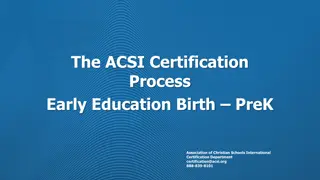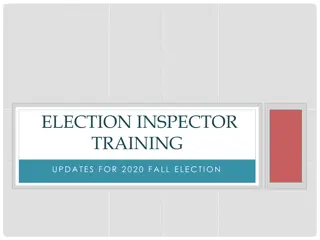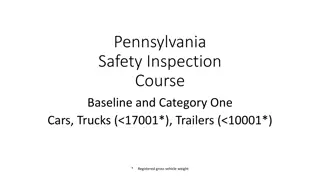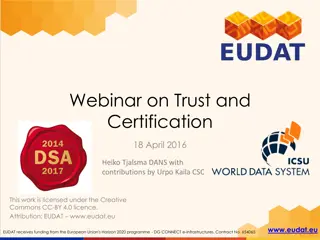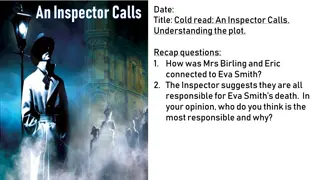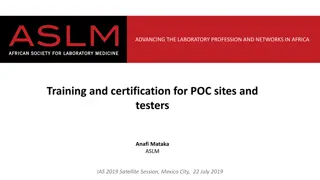Bridge Inspector Certification Requirements and Procedures
This content outlines the requirements and procedures for certification and re-certification of bridge inspectors. It includes information on the inspector's role, responsibilities, skills, and classifications, as well as the certification process for Class B inspectors. The document also highlights the importance of safety-related deficiencies identification, thorough inspections, accurate condition assessment, ratings, maintenance recommendations, and proper documentation.
Download Presentation

Please find below an Image/Link to download the presentation.
The content on the website is provided AS IS for your information and personal use only. It may not be sold, licensed, or shared on other websites without obtaining consent from the author. Download presentation by click this link. If you encounter any issues during the download, it is possible that the publisher has removed the file from their server.
E N D
Presentation Transcript
INSPECTION POLICIES & PROCEDURES Requirements for Certification and Re-Certification
Inspector's Role and Responsibilities Identify safety-related deficiencies. Take appropriate action (immediate if hazard or risk of failure). Perform a thorough inspection. Accurately determine the condition of the bridge components. Rate the bridge elements in accordance with established criteria (BIM Manual). Identify deficiencies and recommend appropriate and timely maintenance. Properly document required items on the appropriate inspection form. Provide additional documentation to back up ratings and maintenance recommendations. Verify, update or collect necessary inventory information. 1
Inspector's Skills Able to recognize safety-related deficiencies. Be decisive in taking appropriate action. Able to accurately determine the condition of bridge components. Understand the rating system. Know the appropriate ratings for the full range of conditions encountered. Able to recognize maintenance requirements and make appropriate maintenance recommendations. Have written communication skills to produce a proper inspection report. 2
Inspector Classifications Bridge Inspectors are classified as Class A or Class B and are certified to carry out inspections of bridge structures on public roads as follows: Class A Qualified to perform a Level 1 inspection on all major bridges, standard bridges, culverts, sign bridges and watercourse training structures (all structure types) Class B Qualified to perform a Level 1 inspection on standard bridges, culverts and watercourse training structures only. 3
Class B Certification Requirements High School Diploma or equivalent education and experience acceptable to AT are required The certification process is 5 Stages: (updated March 22, 2016) Stage 1: Successful completion of Alberta Transportation Class B BIM Training Course (5-day course 70% average score required). Stage 2: Successful completion of AT BIM Field Training Course (3-day Boot Camp ) or AT approved equivalent. Field Trainer recommendation is required). 4
Class B Certification Requirements Stage 3: Successful completion of the mentorship program. Mentor is Class A - or Class B with a minimum of 9 years of certification and approved by AT. Inspect 5 different structure types with a mentor Mentor selects training sites a variety of types Minimum 75% of sites with max. Structural Condition Rating of 45%. Must be accessible. Complete min. 25 training sites under mentor if previously completed AT Field Training OR Complete min. 35 training sites under mentor if previously completed AT approved equivalent Field Training course. Completed within 2 years-otherwise +10/year. 5
Class B Certification Requirements Letter of Recommendation from mentor Provide pdf copies of training inspections with mentor comments and a Summary Spreadsheet Stage 4: Certification exam (min. 75% score required) Stage 5: Test inspections at 3 sites selected by AT completed in 1 day and using blank forms. Sites are previously benchmarked by AT representative and reviewed for acceptability by AT (Stages 4 and 5 can be done in reverse order). 6
Class B Certification Requirements If failure of any stage of the process, then: One chance to redo that stage. Two failures of any stage requires a process to be re-started at Stage 1. Certification after all 5 stages have been successfully completed and with approval from The director of Bridge Engineering. Certification is valid until the next certification renewal date normally 3 years. 7
Class B Re-Certification Process Requires active involvement in BIM and acceptable performance In order to be re-certified, inspectors must meet one of the following criteria: Performed minimum average rate of 2 BIM inspections per month during a previous 3-year period or Performed a minimum average rate of 1 BIM inspection per month during the previous 3-year period and have been active in the management, design, or construction of bridges or Acted as a reviewer for min. avg. rate 2.5 inspections/month OR Department reviewer for a min. avg. rate of 5 inspections/month during a previous 3-year period, and active in management, design, and construction. 8
Class B Re-Certification Process Inspector status is reviewed by AT every 3 years Decision on re-certification is made by AT Assistance from Regional bridge staff as required Inspectors meeting requirements will be re-certified and notified by AT Inspectors not meeting requirements will be asked if they intend to maintain certification. If so, a 3 member AT panel will review the inspector s status and make recommendations to the Director of Bridge Engineering. Panel may develop a plan for the inspector typically writing re-certification exam and 5 test sites 9
Levels of Inspection All formal inspections in Alberta must be performed by a certified inspector Most bridge structures can be visually inspected by a qualified inspector on a routine basis. (Level 1) Some structures or their components will require a specialized inspection (Level 1.5 or 2) in order to: accurately determine their condition gather additional information access components that are not fully accessible during routine Level 1 inspections 10
Levels of Inspection Level 1 Inspection A general inspection Primarily visual, completed without use of specialized equipment or tools Requires completion of the Level 1 BIM inspection report Use of basic tools and equipment Level 1.5 Inspection Level 1 visual inspection but within arms reach of all bridge elements using a manlift, snooper or other specialized access equipment and traffic control. Usually select major bridges with elements not visible/accessible in Level 1 Completed by Certified Cl. A inspector 11
Levels of Inspection Level 2 Inspections: In-depth inspection of culverts, standard, major, or sign bridges. Completed by Certified Cl. A inspector (exception is SBM). Completion of appropriate Level 2 inspection report (e.g. SBM, TCR, CDK) and Level 1 report. Use of specialized knowledge, equipment, tests, or procedures Generally, requires traffic control (exceptions might be TCR, SBM) 12
Inspection Frequency Level 1 inspections performed on all bridge structures on a cycle not exceeding: All structures located on roadways designated as Level 1 or Level 2 in accordance with the Provincial Highway Service Classification every 21 months. All structures located on roadways designated as Level 3 or Level 4 in accordance with the Provincial Highway Service Classification every 39 months. Major bridges on local roads - 39 months. Standard bridges and culverts on local roads - 57 months. All new structures as part of final construction completion. After significant maintenance or rehabilitation. Frequencies intended to provide benefit of inspecting during different seasonal conditions. 13
Inspection Frequency In special circumstances (park road - summer access only) Department may modify frequency. A shorter cycle may be appropriate depending on: age of the structure. traffic characteristics. known deficiencies. inaccessibility of a component or element. If a shorter cycle is necessary, make a recommendation in Special Comments For Next Inspection box. Reviewer will flag and notify AT if in agreement AT will change inspection cycle if in final agreement A date beyond the next standard cycle date will not be accepted by the system. Level 1.5 and Level 2 inspections on a prescribed cycle or an as required basis. Refer to BIM Manual Section 2.5 for more information 14
Training of Inspectors Technical Services Branch manages the delivery of the BIM Bridge Inspection Courses and the BIM Class B Field Training Course (boot camp) Regions responsible for field training Department Staff Non-Department staff are responsible to arrange for additional field training after completing 3-day BIM Field Training Course by engaging an appropriate mentor (Stage 3 Mentorship program described earlier) 15
Responsibility for Inspection Technical Services Branch Develop and manage the BIM System. Develop and monitor standards, policies and procedures. Perform audit inspections with assistance from Regions as required Provide technical support to Regions. Maintain and oversee updating of inventory databases. Refer to Section 2.2 and 2.4.1 for further information 16
Responsibility for Inspection Regions Manage inspection programs for Provincial Roads and major bridges on Local Roads through BIM inspection consultant. Carry out ad hoc inspections. Arrange for specialized inspections by others. Review and accept inventory updates. Review and accept inspection reports. Initiate appropriate action where deficiencies are identified. Provide technical support to Local Road Authorities as resources permit. 17
Responsibility for Inspection Local Road Authorities Manage BIM inspection program for Standard bridges and Culverts on local roads. Control and manage the bridge structures in their jurisdictions. Print forms and complete scheduled Level 1 inspections on standard bridges and culverts (in-house or consultant delivery). Monitor all bridge structures as required. Hazardous or structural element concerns (rated 2 or less) are reported to LRA only and are no longer reported to the Regional Bridge Manager Perform maintenance. Refer to Sections 2.3 and 2.4.2 for further information. 18
Responsibility for Inspection All Inspectors Inspectors must follow established guidelines and reporting procedures to ensure that: Proper action is initiated when safety-related concerns are identified. Information is reported in a systematic and organized manner. Proper expertise is applied to inspection and maintenance. Follow-up is done for maintenance recommendations. 19
Responsibility for Inspection All Inspectors Use the appropriate BIM report for inspections. Carry blank forms for possible structure changes. Assign ratings according to BIM system. Provide ratings that are consistent with explanations and supporting documentation. Gather sufficient information (dimensions, material types, etc.) to initiate structure change when encountered. Verify or revise inventory data on the inspection form. Provide missing inventory data. 20
Responsibility for Inspection All Inspectors Condition ratings of 4 or less the inspector must Provide an explanation of the condition. Supplement with a photo of condition Condition ratings of 3 or less the inspector must; Provide an explanation of condition. Provide photos (also sketches/measurements if needed). Make appropriate recommendation for maintenance (include quantities). (a decrease in the next inspection date might be recommended). 21
Responsibility for Inspection All Inspectors Hazardous conditions or structural load-carrying elements rated 2 or less on structures managed by the Department must be reported within 48 hours to the Regional Bridge Manager and the Bridge Preservation Specialist. Hazardous conditions or structural load-carrying elements rated 2 or less on structures managed by a Local Road Authority must be reported to the LRA only, within 48 hours. Rating of 1 on an element critical to the safe operation of the bridge, take immediate steps to close or restrict traffic on the structure and provide appropriate notification. Report any deficient signage to the appropriate road authority as soon as possible. 22
Responsibility for Inspection All Inspectors Send completed inspection forms with all supporting documentation to Department s BIM consultant for review and entry of inventory updates and inspection data into BIS. Inspection reports will be returned to the inspector if requirements are not met. Inspector must revise report and resubmit to the BIM consultant. Inspector should contact the BIM consultant or the Bridge Manager if there are concerns or questions about the review process. Monitor and maintain certification. 23
Certification Process Following is the link to the Certification and Re-Certification Process for bridge inspectors: https://open.alberta.ca/publications/bridge-inspection-and-maintenance-bim- system-inspector-certification-process 24


